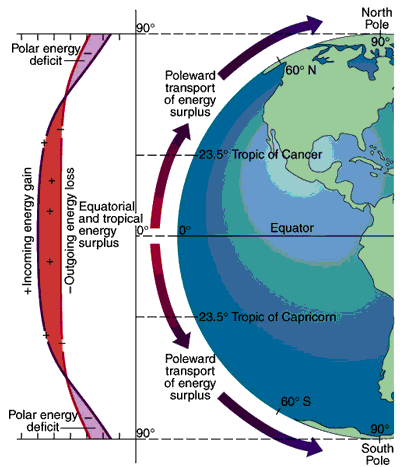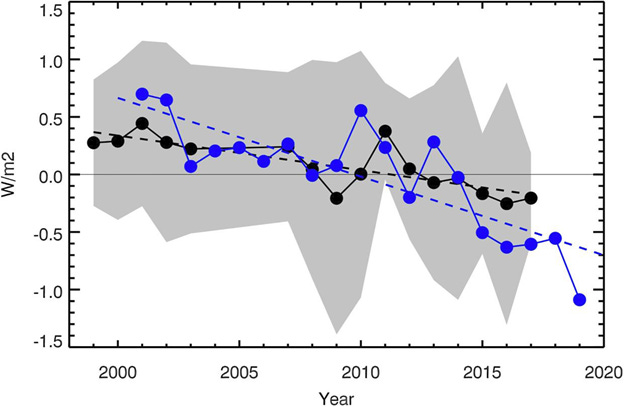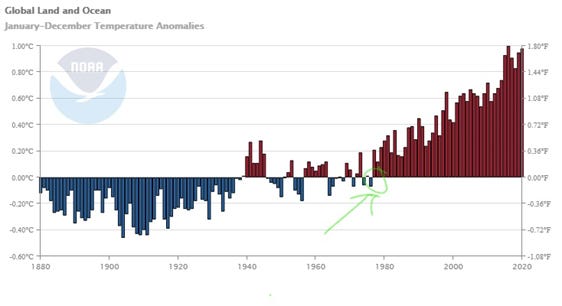The Crisis Report — 07 : Heat doesn't "just happen" - Part Two
The Earth's Albedo has dimmed since the 90's. In the clinical language of science, this is an "unexpected feedback".

Open ocean and ice exhibit a big disparity in albedo. When the Arctic Ocean becomes ice free during the summer in a few decades, it will absorb 78% more energy. Arctic warming will accelerate rapidly as this happens. Models suggest this will add 0.5℃ to global warming by 2100, in addition to the warming caused by CO2 and CH4.
Right now, our world is rapidly heating up. All of us with half a brain can see it happening.
Between 1975 and 2015 it warmed at a rate of about 0.18C per decade (normal interglacial warming for the last 800K years is about 0.1C per century). Unfortunately the planet has started warming up at an even faster rate in the last eight years.
We know this for certain because we measured its reflectivity.
What reflectivity is and why it matters
“Reflectivity” is about what you would expect. It’s a measure of how much energy a surface absorbs and how much it “reflects “away. We intuitively understand this phenomenon.
“Dark objects left out in the sun get warm. Lighter-colored objects, not so much. On a planetary scale, this simple, familiar phenomenon — associated with a characteristic called albedo — drives weather and climate.”
The degree of reflectivity of a material in astronomical terms is its “albedo”.
Core Concept: Albedo is a simple concept that plays complicated roles in climate and astronomy
Different parts of a planet have different albedoes. Some parts, like the poles, reflect almost all of the solar energy that falls on them. Other parts, like the oceans, absorb almost all that solar energy.

The sum total of all the regions on a planet is its planetary albedo.
On average, about 29% of the sunlight that hits the Earth bounces back into space.
The planetary albedo basically determines the Earth’s average temperature. If albedo rises (meaning that more light gets reflected back to space), all other things staying equal, our planet gets cooler. If planetary albedo declines, the earth warms up.
Here’s the bad news: the Earth’s albedo has been declining during the last 20 years.
Earth’s Albedo 1998–2017 as Measured From Earthshine pub. Aug 2021
Earth observation satellites are constantly measuring the Earth’s albedo using a suite of sensors, and the reflectivity of the planet is measured through earthshine, the light from the Earth that reflects off the Moon. This paper analyzes earthshine measurements between 1998 and 2017 to see if the Earth’s albedo is rising or declining in response to climate change. Here’s their conclusion.
“We have reported a two-decade long data set of the Earth’s nearly globally averaged albedo as derived from earthshine observations. Stringent data quality standards were applied to generate monthly and annual means.
These vary significantly on monthly, annual, and decadal scales with the net being a gradual decline over the two decades, which accelerated in the most recent years (much of the decrease in reflectance occurred during the last three years of the two-decade period the team studied). Remarkably, the inter-annual earthshine anomalies agree well with those from CERES satellite observations, despite their differences in global coverage, underlying assumptions to derive the albedo, and the very different sensitivities to retroflected and wider-angle reflected light.”
The two-decade decrease in earthshine-derived albedo corresponds to an increase in radiative forcing of about 0.5 W/m2, which is climatologically significant (Miller et al., 2014). For comparison, total anthropogenic forcing increased by about 0.6 W/m2 over the same period. The CERES data show an even stronger trend of decreasing global albedo over the most recent years, which has been associated to changes in the PDO, SSTs and low cloud formation changes. It is unclear whether these changes arise from the climate’s internal variability or are part of the feedback to external forcings.”
Notice that last paragraph. It quantifies how much of an effect this change in albedo is having. By 2017 it had reached 0.5 W/m2 (Watts per square meter). That doesn’t sound like much, until you realize that the effect of all our CO2 pollution in 2017 was 0.6 W/m2. Bottom line,
By 2017 the decline in the Earth’s albedo doubled the rate that the Earth was warming. We are warming up twice as fast as we were.
If this keeps up, even if we don’t put any more CO2 in the atmosphere, we will get 4℃ of warming by 2100.

These measurements and observations are incontrovertible. Two separate teams; Goode’s “Project Earthshine” and NASA’s “Clouds and the Earth’s Radiant Energy System” (CERES) measured the Earth’s albedo over the last 20 years. Using different methodologies, they arrived at the same conclusions.
Since the year 2000, the planet has reflected less energy back into space: about one-half a watt per square meter.
The earthshine data also revealed something surprising. The planet dimmed noticeably during its final three years of data collection from 2015 to 2017. In discussion of his team’s paper Goode has stated.
“I would have bet my house that those three years were going to look just like the previous 17. Now we have this really cool mystery.”
What made the Earth dimmer and Global Warming worse?
Is this about clouds?
If you are interested in what I’m saying, let me know by signing up for the free emails. I am going to also be adding some additional content for supporters as soon as I get five signups.
Content is free, informed analysis is expensive.
This has been true since the dawn of time. Experts get paid for their expertise because “being informed” about a topic comes at a cost. It takes time, a lot of it, to know what you are talking about.
Information spreads slowly and unevenly. Even in the age of the Internet. Being “informed” has a cost. It’s why governments and universities pay people to be informed on subjects. It eats up the time of really smart people who want to be paid for their time.
In an age of “free information”, individuals trade personal time in order to be informed.
For individuals, “being informed” is a form of unpaid labor. Most people stop updating their worldview in their early twenties. Their lives get busy and something has to be cut back on.
If you haven’t been staying current on the Climate Crisis a LOT is happening right now. What’s happening right now, and in the next few year’s will shape how the rest of your life plays out.
Here’s a really helpful way to visualize and understand what’s happening and how it’s likely to play out.
One of the best documentaries on climate change I have seen came out in 2010. It was called “Earth 2100”. If you haven’t seen it, here’s a link to it on YouTube:
Hosted by ABC journalist Bob Woodruff, the two-hour special explored what “a worst-case” future might look like as climate change plays out over the 21st century.
The show documents the life of a fictitious storyteller, “Lucy” born in 2009 as she describes her life through the 21st century. The program presents snapshots of the Earth in the years 2015, 2030, 2050, 2085, and 2100 with analysis by scientists, historians, social anthropologists, and economists, including Jared Diamond, Thomas Homer-Dixon, Peter Gleick, James Howard Kunstler, Heidi Cullen, Alex Steffen and Joseph Tainter.
It is a little bit dated, but its strength is that it shows how climate change is going to play out over the lifetime of a person born in 2009. It really gives you a sense of what’s in store for the children who are being born today. How the Climate Crisis is going to play out over our lives.
Here’s the thing though. It’s happening 40-50 years earlier than they expected.



